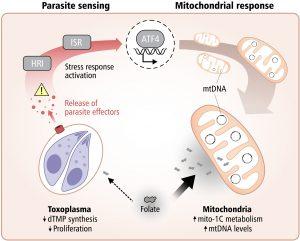We often learn that mitochondria are the “powerhouse of the cell,” producing the energy that keeps life running. New research shows they have another surprising role: acting as defenders by starving pathogens of the nutrients they need to survive (Figure 1).

Figure 1: Graphical abstract. Host cells weaponize mitochondrial metabolism. Upon detection of secreted parasite effectors, host cells activate the ISR. The ISR effector ATF4 increases mtDNA levels and induces mitochondrial one-carbon (mito-1C) metabolism, thereby restricting Toxoplasma access to the folate(s) that it requires for dTMP synthesis and growth.
The team discovered that mitochondria compete with the parasite Toxoplasma gondii for vitamin B9 (folate), a nutrient both the host and the parasite require. By consuming more folate during infection, mitochondria deprive T. gondii of this critical resource, slowing its ability to replicate.
- gondii is a common parasite spread through undercooked meat or cat faeces. While often harmless in healthy people, it can cause severe complications during pregnancy and in those with weakened immunity. In mice, infection alters brain function to make them less fearful of cats, benefiting the parasite’s life cycle. In humans, the greatest risk is congenital infection, which can disrupt fetal organ development.
The team showed that when cells detect the parasite’s secreted proteins, they activate a stress-response pathway regulated by ATF4, a transcription factor. This boosts mitochondrial DNA production and ramps up metabolism. Instead of fuelling the parasite, however, the mitochondria shift into a defensive mode: they consume more folate for their own processes, starving the invader.
When the researchers deleted ATF4, T. gondii grew more easily, proving that the host’s mitochondrial response was key to suppressing infection. The mechanism highlights how mitochondria, descended from ancient bacteria through endosymbiosis, retain the ability to outcompete microbial intruders.
The findings not only reshape how we think about mitochondria but also point toward new therapeutic strategies. Adjusting vitamin intake or manipulating mitochondrial metabolism could one day strengthen the body’s natural defences against infections that exploit nutrient pathways.
Journal article: Medeiros, T. C., et al. 2025. Mitochondria protect against an intracellular pathogen by restricting access to folate. Science.
Summary by Stefan Botha










